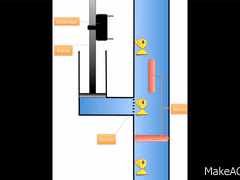2016
Sustainable Technologies
Sound in the form of noise is generally present everywhere we go. It may range from a library-like conversation to a sound of a jet taking off. However, this “noise” dissipates into our environment and without it being utilized at all. Energy in the form of mechanical vibrations, by which sound is governed,
The present photovoltaic (PV) cells use only about half of the light spectrum provided by the sun because the infrared part is not utilized to produce electricity. Without storage or backup generation, PV systems are not a continuous and reliable power source. As a result, they have high energy cost of manufacturing, installation and maintenance. In solar thermal systems,
The next challenge in the globalized world will be to provide populations in developing countries the easy access to fresh water and electricity. However, most of the rural population in sub-Saharan Africa and Southeast Asia live in scattered agglomerates that make the building of traditional infra-structure (electricity grids and water systems) not feasible from an economic standpoint.
Natural Fibers such as Bamboo, Banana Trees, Coconut Husks, Coconut splinter and other such fibrous vegetation systems have the advantages of ready availability, are renewable, and have excellent strength-to-weight ratio. By combining with appropriate Polymers and other ingredients,as well as by hybridizing with glass fiber systems,
The HydroCharge is a portable, self-sustaining charging dock, that is perfect for the environmentally conscious outdoorsman on the go. This compact design with a small and efficient turbine is only 8” x 10” x 2” and weighs approximately 2lbs. This product is perfect for all of those summer camping trips.
Transportation is one of the basic needs of human life. Most of our transportation is dependent on automobiles powered by fossil fuels. But the fossil fuels are being depleted and emissions from automobiles are causing environmental issues like greenhouse effect, ozone layer depletion, acid rain and pollution.
The problem we're trying to solve is that currently Tractor-Trailers get 6.5 miles per gallon - and spend (on average) $48,000 per year on fuel (per tractor). The trucking industry spends $150B per year on fuel in the U.S., and 6.2% of all U.S. emissions come from trucks.
The problem:
Dams block fish on their way to spawn.
Fish ladders are ineffective for fish like sturgeon.
The result is costly fisheries that have to raise millions of fish each year.
Upstream ecosystems are severely damaged by the lack of fish that used to breed there.
1. ORC Unit: Organic Rankine Cycle is a power generation Plant; on a mini-scale; typically in the range of 10 to 250 kW. The main differences between the large thermal power plants which operate on conventional steam based Rankine cycle and ORC are:
a) Working fluid is an Organic fluid; typically a refrigerant e.g. R245fa..
Page 7 of 16









